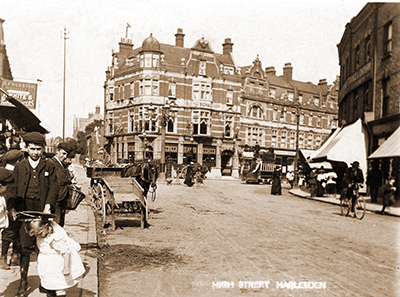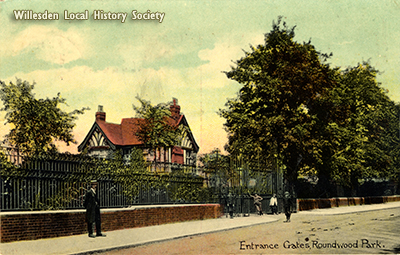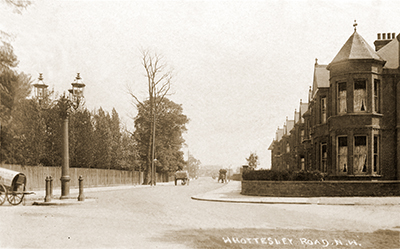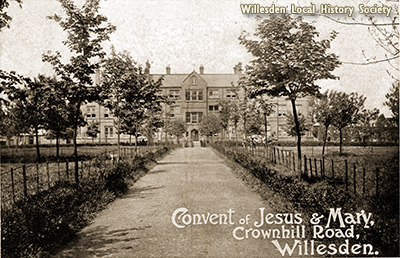
Harlesden

Harlesden lies in the south of Willesden Borough, along the Harrow Road between Stonebridge and Kensal Green. Harlesden is recorded in the Domesday Survey of 1087 as “Herulvestune”. The Manor of Harlesden was under the jurisdiction of St. Paul’s Cathedral, who owned land in Willesden since Saxon times. The survey records this entry – “The Canons hold Herulvestune as one Manor. In the demesne there are two ploughs. There are twenty-two villanes, (tenants paying tithes to St.Paul’s.) Wood for one hundred pigs. In the whole it is worth thirty shillings. The Manor was in the time of King Edward, (The Confessor,) and is now in the demesne of the Canons of St. Paul’s.”
The village grew up beside Harrow Road and around the Village Green, common land which stretched from Harlesden Lane (now Park Parade) to Kensal Green. The parish Church of St. Mary, Willesden, was a mile away across the fields at Church End. It had stood there since the 12th Century, hardly accessible to people on foot, during wet winter weather. The north edge of the Village Green was bordered by Green Lane, which is now called Wrottesley Road. The village was surrounded by farms, and most people had agricultural work on the land, or caring for horses and other animals. Other trades which served the horse industry were blacksmiths, saddlers, wagon and wheel makers, harness makers, etc.
Harlesden was high up on the fertile land rising up out of the valley of the River Brent. There were dairy farms, hayfields and market gardens. Harlesden was described as a beautiful area of the countryside, within reach of the City of London. City businessmen built some large houses in the area, in preference to living in the smoke of London (such as Bramshill Lodge and Harlesden House on Acton Lane.)
Harlesden remained a farming community until the early 19th Century, when the first long-distance railway in England, the London to Birmingham Railway (or London North Western Railway), was built by Robert Stephenson, across the fields south of Harlesden, towards the great brick viaduct crossing the Brent Valley near Twyford. The railway opened in 1837, but the Harlesden area was not affected much, until the opening of a station, temporarily at Acton Lane, in 1841, replaced by one at Willesden Junction in 1866 (just outside Willesden boundary, in Hammersmith.) Railway workers had houses provided for them by the LNWR Company, at Greenhill Park, Rucklidge Avenue and Manor Park Road. Rucklidge Avenue was built on part of the Village Green, Manor Park Road on the land of Manor Farm, in the centre of the village. More railway housing was built by Col. R.J. Nightingale Tubbs, south of Acton Lane, near Willesden Junction Station.
The first railway was joined by many more during the next few years, as freight, and later, passenger traffic increased, and people continued to crowd into the area for work. By the end of the 19th century the new population of Harlesden was served by 9 new churches and chapels, including All Souls Church in Station Road (the new Parish Church of Harlesden), and a large Methodist Church with a tall spire, in Harlesden High Street. Harlesden already had several inns and public houses, such as the Crown, Elm Tree, Royal Oak and Green Man, in the High Street. The Crown and Green Man were coaching inns during the days of horse power. These old hostelries remained popular with the new working class. Other new amenities were the Police Station at Craven Park, Harlesden Library, the County Court, banks, and an influx of shops opening for business all along the High Street. The Jubilee Clock was erected in 1888, a year after Queen Victoria’s Golden Jubilee. It was paid for by public subscription and other donations, indicating the civic pride of the population of Harlesden.
The new families needed schools, so several large Board Schools were built by the Willesden School Board, to join earlier church schools, such as the Convent of Jesus and Mary, and John Keble Church of England School in Crownhill Road. The High Street shops were updated or rebuilt in the Edwardian period. Many of those shopfronts survive a century later. They were refurbished again in the 1980s by the Harlesden City Challenge project. New street furniture and general beautification of key buildings gave the High Street a face-lift, which, it is rumoured, will be repeated during the next few years.
The years of World War 2 brought some destruction and displacement to the area. Some landmark buildings were damaged, such as the Wesleyan Methodist Church in the High Street, which had to be demolished, and the Hippodrome Theatre, which was totally destroyed by a land-mine. Schools were also damaged. Bridge Road and Furness Road Schools has their roofs and top floors blown off. Many streets in Harlesden show the scars of bombing, where mid 20th century houses have been inserted between Victorian terraces. The field beside Roundwood Park is still known as “The Prefabs” even though those temporary war-time replacements have long gone.
Harlesden has excellent transport links. Through the years the horse-buses were replaced by trams, trolley buses, and motor buses, keeping Harlesden connected to central London, Wembley, Hammersmith and Fulham, Kensington, Cricklewood, Hendon and beyond. The local Tube trains and Overground services are convenient for the daily commute.
Harlesden’s population declined between 1950 and 1970, but this was balanced by new immigration from the West Indies, the Indian subcontinent and Kenya from the 1960s. Harlesden is now famous as the centre for the Black Music Industry. Harlesden’s school population has been a wonderful mix of children from varied backgrounds, joined in the 1980s and 90s by unfortunate young asylum-seekers from war-torn places in Africa and eastern Europe. Some of these families moved on, but many have made Harlesden their home. The diversity is reflected in the High Street shops today, with the many different kinds of fish, fruit, vegetables and spices available, and the multitude of fast food outlets. The old church buildings are being used by many groups of people, worshipping in their own way, in peace and harmony, in multicultural Harlesden.
Margaret Pratt, 2021



